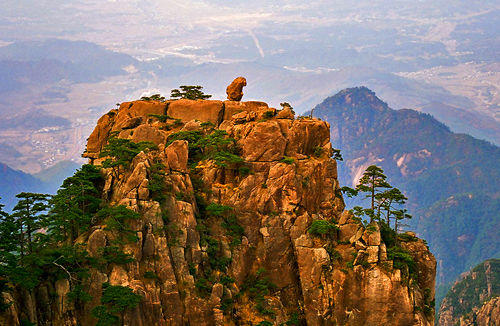




A Brief History
Your Home for everything Ancient China
Li River (Guangxi)
The Li River, also known as Guangxi, is a river that flows for 83 km from Guilin to Yangshuo. This river is famous for its Li River cruise.

The Li River is located inthe Mao'er Mountains in Xing'an County. The river flows 437 km and is flanked by both sides by green hills and formations. The river is often visited by tourists, who come in a variety of boats, inculding bamboo rafts to larger ships. Guangxi is also famous for a limestone cave containing multiple stalagmites, stalactites and cave corals.
Websites : (1)
The Yellow Mountains (Huangshan)
Huangshan, better known as the Yellow Mountains, is a mountain range in southern Anhui province in Eastern China. Its highest point is 1,864 m from sea level. It is also one of the destinations on The World Heritage List and is one of China's most popular tourist destinations.

The Yellow Mountaisn are best known for its beautiful sunrises/sunsets, snowy winters and its view of mountain peaks for more than 200 days of the year. Most of the peaks are more than 1,000m above sealevel. The three tallest and best know peaks are Lotus Peak (1,864m), Bright Summit Peak (1,840m) and Celestial Peaks (1,829m). Overall, the mountain range covers 154 square km. The vegetation of the land varies with elevation. Below 1,100m is covered with Mesic Forests.
Physical Features

Anywhere from 1,100m and 1,800m, the mountains are covered in forest. Anywhere above that is covered in alpine grasslands. There are notourious steps carved into the side of the mountain (over 60,00), allowing anyone to walk up them. Also, the Huangshan is famous for its sunrise effect, which turns all the mountains to a nice yellow colour (namesake). A phenomenom known as Buddha's Light can be seen a few times a month.

History
Huangshan was formed approximately 100 million years ago, and gained its unique rocky formation from from the Quaternary Glaciation. It was originally known as Yishian, but was later changed in 747 AD to Huangshang (thought to be named after Huang Di). There are many scenic spots that have been named, many with a little story attached to it. In 1982, Huangshan was listed under The World Heritage List.
Tourism
Huangshan has over 140 sections, which is most likely why it is such a major tourist destination. In fact, in 1987, the town changed its name to Huangshan to promote itself more. In 2007, over 1.5 million people visited Huangshan (town/mountain). There are over 50 km of pathways open to tourists, and cable cars which can bring people from the bottom all the way to the top of a summit. There are also hotels and guest rooms to accomadate overnight visitors, hoping to see the sunrise.
Websites : (2)
